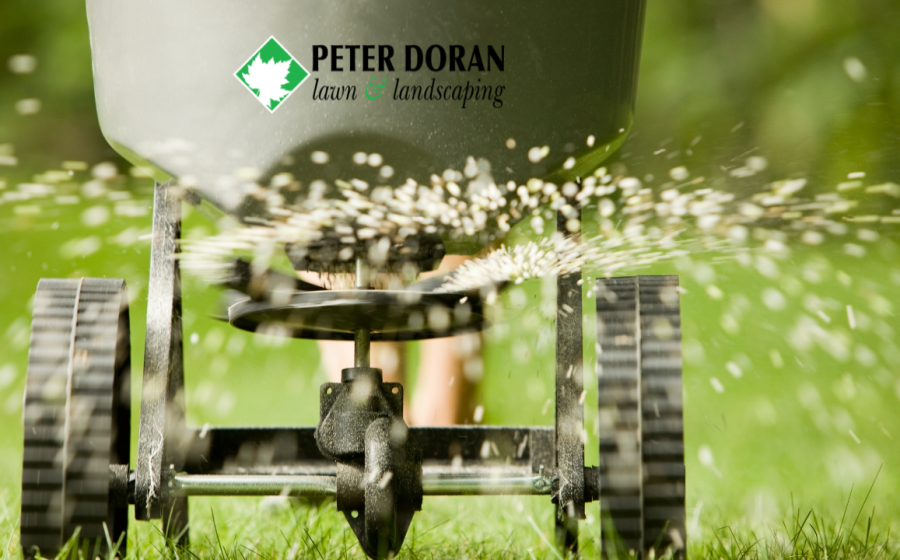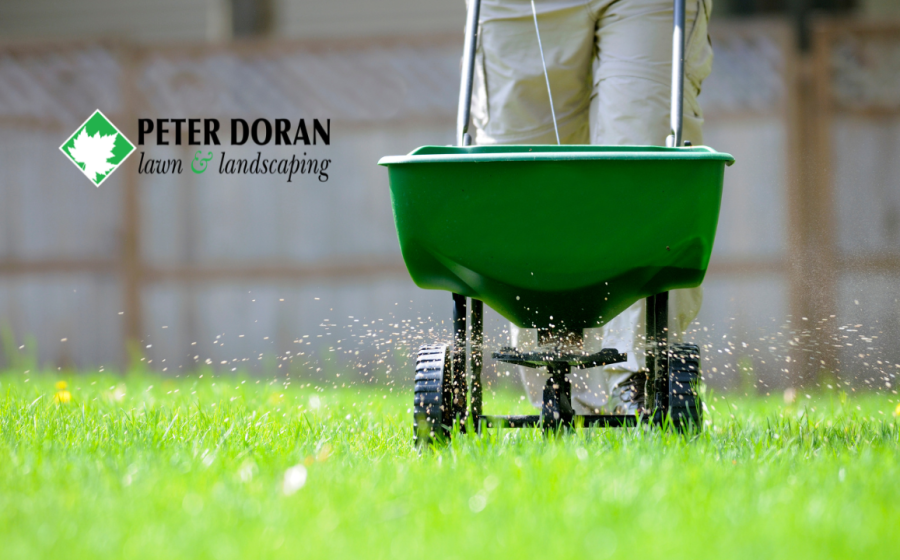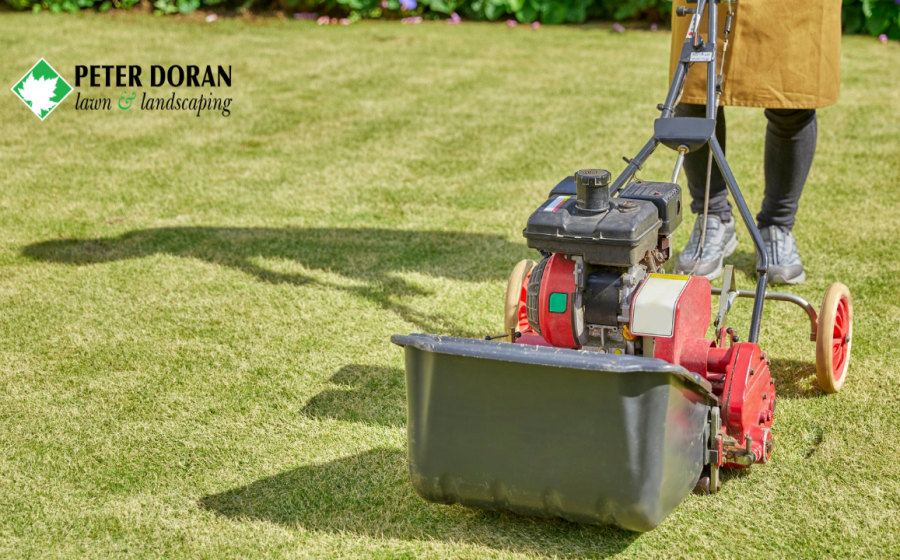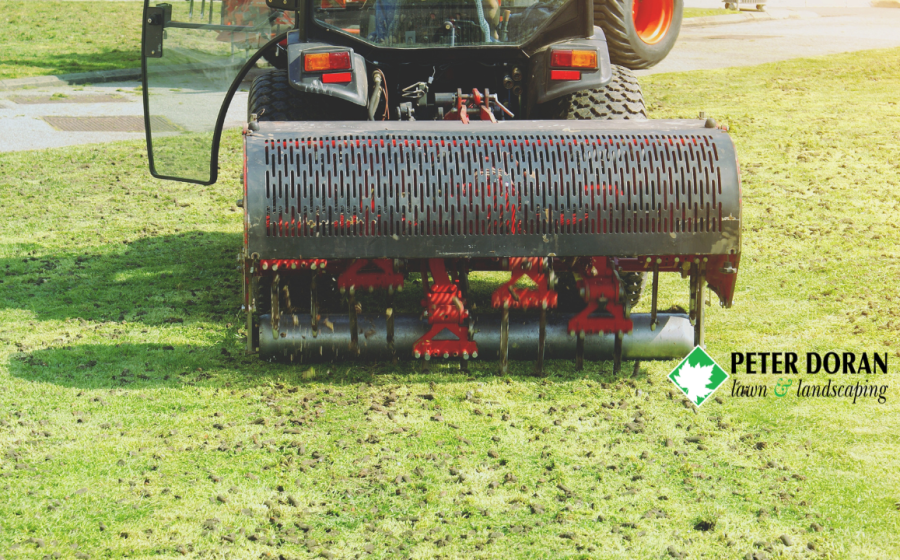- (763) 595-1440
- info@peterdoranlawn.com
- 14360 James Rd, Rogers, MN
Top 5 Benefits of Professional Fertilization for Compact Yards
Healthy lawns in compact yards are more than just a visual treat; they can significantly enhance your urban living experience. Beyond aesthetics, a well- maintained lawn can provide a serene retreat from the hustle and bustle of city life.
However, achieving such a lush lawn requires more than just occasional watering and mowing. This is where professional lawn fertilization comes into play, offering targeted solutions that cater specifically to the needs of small urban yards.
Benefit 1: Expertise in Lawn Health
When it comes to maintaining lawn health, one size does not fit all, especially in compact yards. Professional lawn care specialists possess the expertise required to assess the specific needs of these smaller spaces accurately.
For instance, compact yards often face unique challenges such as limited sunlight, poor soil quality, and restricted airflow, making it crucial to have a tailored approach to fertilization.
Professional knowledge is indispensable in determining the right type of lawn fertilizers and the appropriate application methods. A specialist can evaluate factors like soil pH, grass type, and local climate conditions to recommend the best slow-release fertilizers.
These fertilizers are designed to provide a steady supply of essential nutrients like nitrogen and phosphorus, ensuring your lawn stays healthy and vibrant over time. Without this expert assessment, homeowners risk over- fertilizing or using the wrong products, which can lead to patchy growth or even damage the lawn.
Benefit 2: Customized Fertilization Plans
One of the standout advantages of professional fertilization is the ability to create customized fertilization plans tailored specifically for compact yards. Every yard is unique, and professional services recognize this by offering personalized solutions that address your lawn’s particular needs. This level of customization is crucial in ensuring that your lawn receives the right nutrients at the right time.
Professional services develop fertilization schedules based on yard size, soil type, and seasonal changes. For example, a compact yard with clay soil might require a different fertilizer regime than one with sandy soil.
By tailoring the fertilization plan to these specifics, professionals can optimize nutrient absorption and promote healthy growth. This meticulous approach ensures that your lawn not only looks good but also thrives in its urban environment.
Benefit 3: Time and Effort Savings
Time is a precious commodity, especially for urban homeowners juggling busy lifestyles. Professional fertilization services offer significant time and effort savings by taking over the demanding task of lawn care. Instead of spending weekends trying to fertilize your lawn, you can sit back and relax while experts handle the job efficiently.
Professional fertilization reduces the need for DIY maintenance, allowing you to enjoy a lush lawn without the hassle. Imagine coming home after a long day and finding your yard looking pristine, thanks to the diligent work of professionals. This convenience is not just about saving time; it’s about enjoying peace of mind knowing that your lawn is in capable hands.
With services like Peter Doran Lawn, you can trust that your lawn care needs are met with precision and care, leaving you more time to enjoy your urban oasis.
Benefit 4: Enhanced Appearance of Landscaping
A professionally fertilized lawn can transform the appearance of your compact yard dramatically. The lush, green grass that results from expert fertilization not only enhances your landscaping but also elevates the overall aesthetic of your home. In urban settings, where space is limited, a well- maintained lawn can provide a refreshing splash of color and life.
The impact of healthy, green grass on your home’s appearance cannot be overstated. It creates a welcoming atmosphere and increases your property’s curb appeal. Whether you’re hosting a garden party or simply enjoying a quiet afternoon outdoors, a vibrant lawn sets the perfect backdrop. Professional fertilization ensures that your lawn stays in peak condition, making your home stand out in the urban landscape.
Benefit 5: Long-Term Cost Savings
While professional fertilization might seem like an upfront investment, it offers significant long-term cost savings. When you compare the costs of professional services with DIY methods, the latter often involves trial and error and can lead to costly mistakes. Over-fertilizing or using the wrong products can damage your lawn, necessitating expensive repairs.
Professional care prevents these issues by providing the right nutrients in the right amounts, reducing the risk of lawn damage. This proactive approach not only maintains the health of your lawn but also saves you money in the long run.
By investing in professional services like those offered by Peter Doran Lawn, you’re ensuring a healthy lawn that requires fewer interventions, ultimately lowering your overall lawn maintenance expenses.
Why Small Lawns Need Specialized Fertilization Services
When it comes to managing a small lawn, many homeowners might assume that it’s petite size makes it easy to maintain. However, like any living organism, a small lawn has its own set of unique needs that require careful attention.
One of the most crucial aspects of maintaining a beautiful small lawn is ensuring it receives the right fertilization. Specialized fertilization services are not just a luxury–they are essential to achieving optimal growth and health for your lawn.
Proper fertilization is the lifeblood of any lawn, but for small lawns, it becomes even more critical. With limited space, every blade of grass counts, and the impact of mismanaged nutrients can be more pronounced.
For homeowners, investing in specialized small lawn fertilization services can not only enhance the aesthetic appeal of their property but also contribute to the longevity and sustainability of their green spaces.
Understanding the Unique Needs of Small Lawns
Small lawns present a particular set of challenges that differentiate them from their larger counterparts. They often exist in compact settings where the availability of sunlight, water, and air circulation can be limited. This environment can make it difficult for grass to thrive, requiring a strategic approach to lawn care.
Additionally, small lawns are susceptible to compacted soil, which can hinder root growth and nutrient absorption.
The size of a lawn directly influences its nutrient requirements and growth patterns. With less surface area, small lawns can suffer from nutrient deficiencies if not fertilized correctly.
Unlike larger lawns, where nutrients can be spread over a wide area, small lawns need precise applications to ensure each section receives adequate nourishment.
This precision is where specialized small lawn fertilization services come into play, offering tailored solutions that address these unique challenges and promote healthy growth.
Benefits of Specialized Fertilization Services for Small Lawns
Specialized fertilization services offer numerous benefits that go beyond what standard lawn care can provide. One of the primary advantages is improved nutrient absorption.
Tailored fertilization ensures that small lawns can make the most of the nutrients provided, leading to stronger grass and a more resilient lawn. By targeting the specific needs of your lawn, these services enhance the effectiveness of each application, resulting in a lush green lawn that stands out.
Moreover, specialized fertilizers are designed to combat common issues like weed growth and pest infestations. By incorporating specific nutrients and compounds, these fertilizers help prevent unwanted guests from taking root in your lawn.
The result is a healthy, vibrant lawn that not only looks beautiful but also requires less intervention throughout the growing season. This approach promotes sustainable growth, allowing your small lawn to flourish year after year.
Why DIY Fertilization Isn’t Enough for Small Lawns
While the DIY approach to lawn fertilization has its merits, it often falls short when addressing the specific needs of small lawns. General fertilizers available in stores are designed for broad applications and may not provide the concentrated nutrients your small lawn requires.
Without the precise formulation that specialized services offer, your lawn may end up with too much or too little of what it needs, affecting its overall health and appearance.
Hiring professionals like Peter Doran Lawn brings a level of expertise that goes beyond what a DIY approach can achieve. These professionals understand the nuances of lawn fertilization and are equipped to create custom lawn care plans that cater to the specific demands of small lawns. Their experience and knowledge ensure that your lawn receives the attention it deserves, resulting in a green lawn that is both beautiful and robust.
Choosing the Right Fertilization Service Provider
Selecting the right fertilization service provider is crucial for ensuring your small lawn receives the best care possible. Start by researching local companies and seeking recommendations from neighbors or friends who have successfully maintained small lawns. Look for providers with a track record of excellence and a commitment to using high-quality products and methods.
Customized solutions are a hallmark of a quality service provider. Companies like Peter Doran Lawn offer tailored fertilization plans that account for the specific characteristics of your lawn.
By choosing a provider that prioritizes personalized care, you ensure that your lawn receives precisely what it needs to thrive, from the right blend of nutrients to the perfect timing of each application.
Conclusion
In conclusion, small lawns require specialized fertilization services to meet their unique needs and achieve their full potential. By investing in professional care, homeowners can enjoy a lush green lawn that enhances the beauty of their property and stands the test of time.
Overseeding After Aeration: Steps to a Thicker, Healthier Lawn
Imagine stepping out onto a plush, green carpet every morning as you sip your coffee. Your lawn can be that inviting oasis with the right care and attention. One of the most effective strategies to achieve this is overseeding after aeration. This dynamic duo not only revitalizes your lawn but also ensures it remains lush and healthy throughout the seasons.
Overseeding after aeration involves two essential lawn care practices: aerating your lawn to relieve soil compaction and overseeding to introduce new grass plants. These steps are critical to maintaining a vibrant lawn, especially if it’s been looking a bit tired or patchy.
In this guide, we will walk you through the process step-by-step, empowering you with the knowledge to transform your lawn into the envy of the neighborhood. Whether you’re a seasoned DIY enthusiast or new to lawn care, this guide is designed to be supportive and easy to follow.
Understanding the Benefits of Overseeding After Aeration
Aeration is the process of creating small holes in the soil to alleviate soil compaction, allowing air, water, and nutrients to penetrate the grassroots effectively. This practice is crucial because compacted soil can suffocate your grass, preventing it from accessing essential resources. Aeration not only allows your lawn to breathe but also provides a perfect environment for new grass seed to establish.
On the other hand, overseeding involves spreading grass seed over an existing lawn to thicken it and improve its resilience. It introduces new grass varieties that are often more drought-resistant, disease-tolerant, and vibrant than older grass types.
Together, aeration and overseeding form a powerful combination that rejuvenates your lawn, filling in bare spots and creating a dense, uniform surface that can withstand the elements.
Preparing for Overseeding
Timing is everything when it comes to overseeding after aeration. The best time to aerate and overseed your lawn depends on your climate and grass type. Generally, early fall is ideal for cool-season grasses, while late spring or early summer works best for warm-season varieties. This timing allows the grass seed to establish before extreme temperatures set in.
Before you begin, assess your lawn’s current condition. Is it patchy, thin, or showing signs of wear? If so, overseeding is a wise choice.
You’ll also want to gather the right tools and materials. A core aerator, available for rent at most garden centers, will be essential for aerating your lawn.
Additionally, you’ll need high-quality grass seed suited to your region, a spreader for even distribution, and a reliable watering system.
Preparing your lawn for overseeding isn’t just about having the right tools; it’s about understanding your lawn’s specific needs. Take a moment to observe your lawn’s health and growth patterns. This insight will guide you in selecting the best grass seed and timing your efforts for maximum impact.
Step-by-Step Guide to Overseeding After Aeration
Step 1: Aerate the Lawn
Begin by aerating your lawn. Use a core aerator to remove small plugs of soil across your lawn. This process reduces soil compaction and creates spaces for air, water, and nutrients to reach the roots. Aim for a pattern that covers the entire lawn, with holes spaced about 3-6 inches apart. Remember, a well- aerated lawn is the foundation for successful overseeding.
Step 2: Prepare the Soil
Once your lawn is aerated, it’s time to prepare the soil. Rake away any debris, such as leaves or thatch, that might prevent the grass seed from making contact with the soil. This step ensures that the new seeds have the best possible chance to germinate and establish roots.
Step 3: Choosing the Right Grass Seed
Selecting the right grass seed is crucial for a successful overseeding project. Consider factors like climate, sun exposure, and your lawn’s soil type. Opt for a seed mix that complements your existing grass and introduces improved traits, such as drought resistance or disease tolerance. Investing in high-quality seed will yield better results and a more resilient lawn.
Step 4: Spreading the Seed Evenly
With your grass seed in hand, use a spreader to distribute it evenly across your lawn. Follow the recommended seeding rate on the seed packaging, and aim for full coverage without over-seeding, which can lead to competition among seedlings. Ensure that the seeds make good contact with the soil to promote germination.
Step 5: Watering and Maintenance Post-Overseeding
After overseeding, water your lawn gently but thoroughly. Keep the soil consistently moist until the new grass reaches about 2 inches in height. Avoid overwatering, as this can wash away seeds or lead to fungal issues. Once the grass is established, gradually reduce the frequency of watering, allowing the roots to grow deeper.
Troubleshooting Common Issues
Even with the best intentions, your overseeding efforts may encounter a few bumps along the way. Patchy growth can occur if the seed distribution wasn’t even. To remedy this, consider re-seeding sparse areas and ensuring adequate watering.
Excessive weed growth may also be an issue, particularly if the lawn wasn’t properly prepared before overseeding. Use a pre-emergent herbicide specifically designed for new grass if necessary, but always follow label instructions.
Soil compaction can still pose a challenge if the lawn wasn’t sufficiently aerated. If you notice persistent issues, consider repeating the aeration process. Regularly monitor your lawn’s progress and adjust your care routine as needed. Remember, a thriving lawn is a result of consistent attention and care.
Tips for Maintaining a Thick and Healthy Lawn Post-Overseeding
Now that you’ve overseeded your lawn, maintaining its health is key to ensuring long-term success. Establish a proper watering schedule, gradually transitioning from frequent, shallow watering to less frequent, deep watering. This approach encourages deep root growth and resilience.
Mowing and maintenance practices also play a vital role in your lawn’s health. Avoid mowing until the new grass is at least 2-3 inches tall, and then only remove the top third of the grass blade. Regular mowing will help maintain a uniform appearance and prevent stress on the new grass.
Fertilizing your lawn will provide essential nutrients that support growth and recovery. Choose a balanced fertilizer and apply it according to the manufacturer’s instructions. A healthy lawn is a result of consistent care and attention, ensuring it remains thick and vibrant year-round.
Conclusion
Incorporating overseeding after aeration into your lawn care routine can transform your outdoor space into a lush, green paradise. By understanding the benefits of aeration and overseeding, preparing properly, and following a step-by-step guide, you’re setting your lawn up for success.
At Peter Doran Lawn, we understand the challenges and rewards of maintaining a beautiful lawn. Our aeration and overseeding services are designed to help both homeowners and business owners achieve their lawn care goals. If you’re looking for expert assistance, we’re here to provide the support you need.
Signs Your Lawn Needs Aeration: Don’t Ignore These Warnings
Signs Your Lawn Needs Aeration: Don’t Ignore These Warnings
Aeration is a crucial process that involves perforating the soil with small holes to allow air, water, and nutrients to reach the grassroots. Recognizing the signs that your lawn needs aeration can make a significant difference in its overall health and appearance.
As a homeowner, it’s important to stay alert to the subtle signs that indicate your lawn needs to be aerated. Ignoring these warnings can lead to a decline in your lawn’s health, making it more susceptible to disease, dry spots, and overall thinning.
In this blog post, we’ll explore the key signs that suggest it’s time to aerate your lawn, and how addressing these issues can restore its vitality. Let’s dive into the details and help you maintain a thriving, beautiful lawn.
Understanding Aeration
Aeration is a fundamental component of any lawn care routine. At its core, aeration involves creating small holes in the soil using tools such as hollow tines or spikes. This process alleviates soil compaction, allowing your lawn to breathe. When the soil is compacted, it restricts the flow of air, water, and nutrients to the roots, which can impede growth and vitality.
The benefits of aeration extend far beyond immediate aesthetic improvements. By aerating your lawn, you improve its ability to absorb water, oxygen, and nutrients–essential elements that aid in the development of a robust root system.
A well-aerated lawn is more resilient to environmental stresses, such as drought and heavy foot traffic. Ultimately, regular aeration is key to maintaining a healthy lawn that can withstand the wear and tear of everyday life.
Incorporating aeration into your lawn care routine not only enhances grass growth but also ensures that your lawn remains vibrant and lush throughout the seasons. By understanding the importance of aeration and being vigilant about the signs that indicate your lawn needs this treatment, you can take proactive steps to preserve the beauty and health of your outdoor space.
Signs Your Lawn Needs Aeration
Patchy or Thinning Grass
One of the most telling signs your lawn needs aeration is the presence of patchy or thinning grass. When soil becomes compacted, it limits the growth of grass by restricting the availability of essential nutrients and water. As a result, you may notice areas where the grass is sparse or where bare soil is visible. This can be particularly common in lawns with clay soil, which is more prone to compaction.
Aeration addresses this issue by creating pathways for nutrients and moisture to reach the roots, encouraging a thicker and more uniform lawn. By allowing the grassroots to access the vital resources they need, aeration promotes vigorous growth and helps to fill in those unsightly bare patches.
Puddles or Standing Water
Another sign that your lawn needs to be aerated is the presence of puddles or standing water after rainfall or irrigation. Compacted soils hinder proper drainage, causing water to accumulate on the surface rather than being absorbed into the soil. This not only creates potential breeding grounds for pests but also deprives the root system of necessary moisture.
Aeration improves water infiltration by breaking up compacted soil and allowing water to penetrate more effectively. This prevents waterlogging and ensures that your lawn receives the hydration it needs to thrive. If you notice persistent puddles or areas where water tends to pool, it may be time to aerate your lawn to prevent water-related issues.
Difficulty Penetrating the Soil
If you’ve ever tried to plant something and found it nearly impossible to penetrate the soil with a shovel or garden fork, you’re likely dealing with soil compaction. When soil is compacted, it creates a dense barrier that inhibits root growth and nutrient uptake. This can lead to stunted grass growth and an overall decline in lawn health.
Aeration helps to alleviate soil compaction by creating channels that allow roots to grow more freely. By improving the soil structure, aeration facilitates the movement of water, oxygen, and nutrients deeper into the soil, where they can be absorbed by the roots. If you’ve experienced difficulty working with your soil, it’s a clear sign that your lawn could benefit from aeration.
Timing and Frequency of Aeration
Knowing when and how often to aerate your lawn is crucial for achieving the best results. The ideal time to aerate varies depending on factors such as climate, grass type, and soil condition. Generally, the best time to aerate is during the growing season when grass can recover quickly. For cool-season grasses, early spring or fall is optimal, while warm-season grasses benefit most from aeration in late spring or early summer.
The frequency of aeration depends on the specific needs of your lawn. Lawns with heavy foot traffic, clay soil, or those that show signs of compaction may require more frequent aeration, possibly once a year. On the other hand, lawns with lighter traffic and loam or sandy soil may only need aeration every couple of years.
For DIY enthusiasts, renting an aerator or using a manual aeration tool can be a cost-effective way to aerate your lawn. However, for larger properties or those with severe compaction issues, hiring a professional lawn aeration service like Peter Doran Lawn can ensure that the job is done efficiently and effectively.
Aeration Methods and Techniques
When it comes to aerating your lawn, several methods and techniques are available, each with its own set of advantages and drawbacks. The most common methods are core aeration and spike aeration. Core aeration involves removing small plugs of soil from the lawn using hollow tines, which helps alleviate compaction and improve soil structure. This method is particularly effective for lawns with heavy compaction or clay soils.
Spike aeration, on the other hand, involves using solid spikes to poke holes in the soil. While this method is less invasive and can be done with a simple garden fork, it may not be as effective as core aeration in relieving compaction. The choice between these methods depends on the specific needs and conditions of your lawn.
When selecting an aeration technique, it’s essential to consider factors such as the level of compaction, soil types, and the size of your lawn. Consulting with a lawn care expert like Peter Doran Lawn can provide valuable insights and help you determine the best approach for your lawn’s unique requirements.
Conclusion
Recognizing the signs that your lawn needs aeration is a crucial step in maintaining its health and beauty. From patchy grass to standing water and compacted soils, these warning signs indicate that your lawn could benefit from the revitalizing effects of aeration. By addressing these issues and incorporating regular aeration into your lawn care routine, you can ensure that your lawn remains vibrant, resilient, and ready to withstand the challenges of the changing seasons.
At Peter Doran Lawn, we understand the importance of a healthy lawn and offer professional services to help homeowners and business owners achieve the lush, green lawns they desire. So, if you’ve noticed any of these warning signs, don’t wait–take action and give your lawn the care it deserves. After all, isn’t a beautiful lawn worth the effort?





Recent Comments